2024 Bio-Gel® Research Findings
Background/Introduction
Bio-Gel technology is a carbohydrate-based hydrogel designed to increase crop production in agricultural production systems. Bio-Gel technology enhances nutrient and water retention, promotes soil organic matter formation, and supports native soil biology. Available from 2022 as a fine dry granular product and since 2024 as a liquid concentrate. The primary focus of this research is to support its use as a soil amendment, bio stimulant and retention agent.
Bio-Gel technology can be used as a tank mix additive with both conventional and organic liquid fertilizers. Bio-Gel enhances fertilizer use efficiency, crop production, and the environmental fate of agrochemicals and fertilizers. Current research focuses on liquid in-furrow applications in corn and soybean production, as well as in-season applications of Bio-Gel mixed with Urea Ammonium Nitrate (UAN) liquid fertilizer.
Site Description
In 2024 we selected twelve experimental sites for assessing the efficacy of Bio-Gel in upper Midwest corn production systems. Site selection was based on farmer participation and willingness to adopt new technologies. Aside from the transfer of knowledge, no financial incentive for participating in the trial was awarded to the farmer for participating in the research.
Six of the locations applied Bio-Gel as an in-furrow starter treatment tank mixed with their grower stand program. The remaining sites applied Bio-Gel tank mixed with Urea Ammonium Nitrate (UAN) at the standard grower practice rate. Applications of Bio-Gel with UAN included y-drop, side-dress, and fertigation through overhead sprinkler pivot. Grower standard practices included low – high fertilities and numerous management practices. Inputs range from bio stimulants to conventional macro and micronutrient fertilizers. Soil descriptions and site background are listed in Appendix A and encompass soil types from fine sand, silts, loams, and clay.
An additional five experimental sites were also established for assessing Bio-Gel efficacy in soybean production systems. Bio-Gel was added as a tank mix additive along with their standard grower practice in-furrow starter applications.
Methodology
Soil and plant tissue samples were collected at each site according to Midwest Laboratories guidelines. Soil samples underwent two analyses: the natural ammonium acetate extraction method and the saturated paste (SPE) method. The SPE method, commonly used in western North America, better represents the short to medium-term nutrient pool, while the ammonium acetate method reflects a long-term nutrient pool.
Experimental Design
Sampling locations for each of the experimental sites were determined based on crop rotation and designed to simulate practical cropping scenarios. Site and sampling locations were determined based on SURGO soil series layers with preference to site locations which replicated soil types in all treatments. Within each treatment and within soil type, three sample locations were selected for soil and plant tissue collection. Individual treatments reported sampling densities between six to nine collection points depending upon soil types available for comparison.
Results
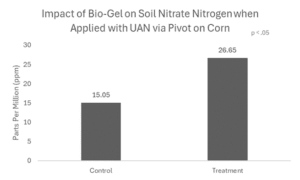
Bio-Gel increased nitrate nitrogen and phosphorus when applied with UAN at side-dress on corn and as a liquid in-furrow starter fertilizer. When Bio-Gel was applied along with UAN through sprinkler pivots at our Kansas experimental site, soil nitrate nitrogen increased 77% (p<.05). The reported increase was equivalent to 23 pounds per acre nitrogen in the upper eight inches of the soil profile. In soybean trials, Bio-Gel increased phosphorus 28% when applied as a liquid in-furrow starter (p<.05). Bio-Gel reported increased nitrogen retention in 63% of corn trials and 95% of the soybean trials.
Figure 1: Mean nitrate nitrogen concentrations (mg/l : ppm) from soil samples collected from the Bio-Gel Kansas experimental site. Bio-Gel increased soil nitrate nitrogen concentrations 77% in the soil samples collected. Samples were collected at V10-V11.
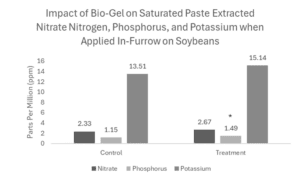
Figure 2: Saturated paste extracted nitrate nitrogen, phosphorus, and potassium concentrations (mg/l : ppm) in soil samples collected from five experimental soybean sites across the upper Midwest in 2024. Samples were collected 30 – 45 days after planting.
Table 2: Single factor, ANOVA statistical analysis of saturated paste extracted phosphorus. Soil samples were collected 30 – 45 days after planting between the grower standard practice (control) and the grower standard practice with Bio-Gel (treatment). Treatments were applied in-furrow at planting on soybeans. Data was collected from five experimental sites across the upper Midwest 2024.

Derived from carbohydrates, Bio-Gel increased water retention in trials when applied along with liquid in-furrow starter fertilizers at corn experimental sites in Wisconsin. Volumetric soil moisture content increased 10% at the three-inch soil depth under the Bio-Gel treatment. Bio-Gel retained soil moisture at a greater volume for approximately 10-14 days after each precipitation event. Seasonal increases equated to increased retention of approximately .3 inches of rainfall retained in this dryland corn production system.
Figure 3: Bio-Gel increased soil moisture 10% at the Watertown, WI experimental site from July-September 2024. The reported increase held .3216 inches more rain per acre than the GSP.

The inclusion of Bio-Gel as a tank mix additive for liquid in-furrow corn fertilizers increased soil organic carbon 9% across 88% of the corn trials. Bio-Gel increased soil organic carbon by .26% across 174 samples collected. As a carbohydrate-based hydrogel, the bio stimulant properties stimulant soil organic caron were more significant in the corn trials than the soybeans. Increases in short-term, liable soil organic carbon, have been discussed as primers for soil microbial carbon pumps and the formation of stable forms of soil organic matter.
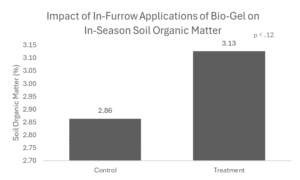
Figure 4: Soil organic matter between the grower standard practice (control) and grower standard practice with Bio-Gel (treatment). All applications were applied in-furrow at planting. Samples were collected V6-V10. Replicated samples within each soil type and between (n=174). Bio-Gel increased soil organic matter 9% a .26% increase between treatment (p-value = .12)
Discussion
Bio-Gel, as a carbohydrate-based hydrogel, has known properties as a retention agent and bio stimulant. The active ingredient, uronic acid, is commonly found in many household and cosmetic products as a moisture retention agent. In agriculture, the results presented suggest that carbohydrate-based hydrogels function as nutrient retention agents and stimulate an increase in soil organic carbon.
The observed increases in nitrate nitrogen and soil organic carbon combined increases nitrogen use efficiency. As inputs to the University of Nebraska nitrogen demand algorithm, the observed increase of 1.97 mg/l nitrate nitrogen and the .26% increase in soil organic carbon/matter improved the .12 units of applied nitrogen per bushel of corn. According to the UNL algorithm, Bio-Gel has the potential to reduce expenses by 24 pounds per acre of nitrogen or provide an uplift in revenue potential by approximately 32 bushels per acre. The current research suggests that the uplift in yield potential with Bio-Gel is a response from increased nutrient and water retention and soil organic carbon simulation with Bio-Gel.
Appendix A: 2024 Bio-Gel Experimental Site Description
Table A1: 2024 In-Furrow Bio-Gel corn experimental site descriptions

Table A2: 2024 Side-dress Bio-Gel corn experimental site descriptions

Table A3: 2024 In-Furrow Bio-Gel corn experimental site descriptions
![]()
Appendix B: Soil Organic Matter Data from Bio-Gel In-Furrow Corn Trials 2024

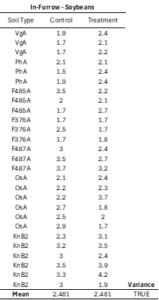
Appendix C: 2022 Bio-Gel Corn and Soybeans Contract Research in Wisconsin and Michigan
Table C1: Replicated yield data and test weight from a randomized complete block design Bio-Gel corn rate trial in Whitewater, WI. Bio-Gel was applied as a tank mix additive with the grower standard liquid in-furrow fertilizer and planted June 15th, 2022.
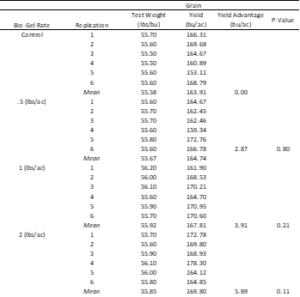
Table C2: Replicated yield data, test weight, and crop performance data from a randomized complete block design Bio-Gel soybean trial in Whitewater, WI. Bio-Gel was applied as a tank additive with the grower standard liquid in-furrow fertilizer and planted June 15th, 2022.
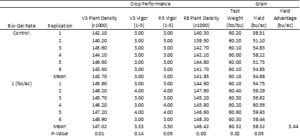
Table C3: Replicated yield data a randomized complete block design Bio-Gel corn trial DeWitt, MI. Bio-Gel, the biological CX-1, and the biostimulant Boost, were all applied at the recommended application rates as a liquid in-furrow fertilizer and planted April 2022.
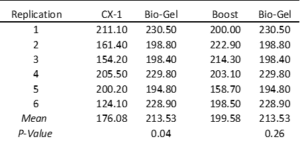
Table C4: Replicated yield data a randomized complete block design Bio-Gel corn trial in Dewitt, MI. Bio-Gel was tank mixed with the biological product CX-1 and separately the biostiumulant product Boost. All products were applied at the recommended application rates as a liquid in-furrow fertilizer and planted April 2022.
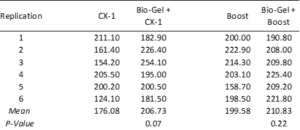
REFERENCES
Abobatta W. Impact of hydrogel polymer in agricultural sector. Adv Agr Environ Sci. (2018);1(2): 59−64. DOI: 10.30881/aaeoa.00011
FAO. 2021. Standard operating procedure for saturated soil paste extract. Rome.
